#amplelogic
Explore tagged Tumblr posts
Text
Why Medical Device Companies Need CAPA Software to Ensure Quality & Safety

In the fast-paced world of medical device manufacturing, ensuring the highest quality and safety is not just a goal—it's a regulatory necessity. Whether it’s preventing defects, reducing risk, or meeting stringent FDA guidelines, medical device companies must maintain rigorous oversight of their processes. One essential tool that’s become a game-changer for quality management is CAPA (Corrective and Preventive Action) software.
CAPA management software helps companies address potential and existing problems in their processes, products, and even documentation. But why is it a must-have for medical device companies? Let's break it down.
1. The Increasing Complexity of Regulatory Requirements
Medical device companies are under intense scrutiny from regulatory bodies like the FDA, which mandates a thorough CAPA process as part of its quality management system (QMS) requirements. Any deviation from expected outcomes must be investigated, documented, and corrected, and that’s where CAPA software steps in.
Manually tracking these actions is not only inefficient but prone to errors, potentially leading to non-compliance. CAPA software automates and streamlines the process, ensuring that every corrective and preventive action is properly documented and traceable.
By utilizing CAPA management software, you can rest assured that your company stays compliant with FDA regulations, ISO standards, and other governing bodies without the headache of constant manual oversight.
2. Improved Root Cause Analysis
One of the cornerstones of CAPA is identifying the root cause of an issue and addressing it to prevent recurrence. Without a systematic approach, identifying this root cause can feel like finding a needle in a haystack. CAPA software for pharma and medical device companies simplifies this by providing structured workflows and analytics to aid in root cause analysis.
Using this software, you can quickly spot trends, identify recurring issues, and prevent them from impacting the quality of your medical devices again. This not only helps with compliance but significantly reduces production downtime and costs associated with defects.
3. Enhanced Risk Management
Risk management is critical in the medical device industry, where any product defect can have life-threatening consequences. CAPA software provides an integrated approach to identifying, assessing, and mitigating risks across the entire lifecycle of a product.
The software enables you to connect CAPA processes with risk management practices, ensuring that any issue flagged in the CAPA system is immediately assessed for risk. This means that potential hazards are caught early, corrective actions are implemented swiftly, and patient safety is protected.
4. Real-Time Data and Reporting
In today’s data-driven world, real-time visibility into operations is essential. CAPA management software offers robust reporting and analytics features, allowing decision-makers to monitor the performance of their quality management processes in real time.
Imagine being able to pull a detailed report on the status of all open CAPAs in seconds. You’ll know exactly which areas of your production line need attention, where risks lie, and how your preventive actions are performing—all without digging through endless spreadsheets.
The ability to access real-time data not only keeps you compliant but ensures your quality control processes are always proactive, never reactive.
5. Increased Efficiency and Collaboration
Let’s face it—managing CAPAs manually is a time-consuming, cumbersome process that often involves multiple departments. From quality assurance to manufacturing, everyone needs to be on the same page.
CAPA software centralizes this process, allowing different teams to collaborate seamlessly. When an issue arises, all relevant stakeholders are automatically notified, action plans are clearly defined, and responsibilities are assigned. This collaborative approach reduces bottlenecks, speeds up problem resolution, and ensures everyone has access to the same information.
6. Scalability for Growing Companies
Whether you're a startup or an established player in the medical device industry, your company’s processes will grow in complexity over time. The beauty of CAPA management software is that it scales with your business.
As your operations expand, you’ll need to manage an increasing number of corrective and preventive actions. CAPA software can handle this growth seamlessly, ensuring that your quality management system remains robust, no matter how big your company becomes.
Conclusion: Invest in CAPA Software to Ensure Quality and Safety
In the world of medical devices, there’s little room for error. Regulatory compliance, patient safety, and product quality are all critical, and CAPA management software ensures that your company maintains the highest standards in all these areas.
By automating and optimizing your CAPA processes, this software can help you save time, reduce risk, and ensure that quality and safety remain at the heart of your operations.
If you’re looking to boost compliance, streamline workflows, and safeguard your products, investing in CAPA software is the way to go. Start today and give your company the tools it needs to succeed in this highly regulated industry!
#pharmaceutical industry#biotechnology#quality#qualitycontrol#qms#amplelogic#qualityassurance#quality management system#biotech#artificial intelligence#capa software#capa management software
0 notes
Text
0 notes
Text
0 notes
Text
Rapid Application Development Market Set to Witness an Uptick during 2018 to 202
The process of application development in every IT firm is entirely different as compared to sales or marketing, notably on account of the multimodal complexities involved. Rapid application development helps firms in terms of creating applications via predesigned frameworks, app builders, and simple & easy drag-and-drop functionalities.
The operational methodology used by rapid application developments is vastly different and progressive as compared to the conventional variants, such as DevOps, waterfall, and agile. Rapid application development offer multipronged benefits, including seamless adaptability, instant system integration, productive user feedback, efficient code generation, and compartmentalization of the system components, which makes it a viable proportion for every company to outperform their business goals. Moreover, vendors in the rapid application development market are enhancing agility and adaptability of their offerings in a bid to stay at the forefront of technological innovations.
Get Brochure of the Report @ https://www.tmrresearch.com/sample/sample?flag=B&rep_id=4872
Rapid Application Development Market- Notable Highlights
In 2018, IBM modernized Domino, its exclusive business app platform, that debuted in the year 1989 with roots in the ‘Lotus Notes’ ecosystem. Domino refers to a platform that is multi-faceted and offers seamless app development by making use of rapid application development approach. Via this revamp, IBM has improved mobile application development, analytics, and cloud support, which remain a mainstay for Lotus Notes.
In 2018, HCL Technologies completed the acquisition of specific software businesses of IBM, which included Domino, Lotus Notes, and Tivoli products. The acquisition was for a deal of nearly $1.8 billion and was believed to boost IBM’s revenue mix.
Some of the most prominent competitors operating in the competitive landscape of global rapid application development market include –
IBM
Google
Oracle
AWS Microsoft
Appian
Salesforce
Kony
Zoho Corporation
ServiceNow, Inc.
OutSystems
Mendix
Ninox
Pegasystems
Matsoft
QuickBase
AppSheet
LANSA
Oro
WaveMaker
Radzen
AmpleLogic
K2
FileMaker
Rapid Application Development Market- Multipronged Benefits of Rapid Application Development to Drive Demand
Rapid application development (RAD) prioritizes agility and speed over anything else, enabling IT firms and business practitioners to boost their productivity and enhance business outcomes. In addition, a host of additional benefits offered by rapid application development models are-
Risk Reduction: RAD enables creating as well as sharing workable prototypes for the business to analyze functionality in the early stages of development, which helps in avoiding reiterations and rework.
Enhanced Quality: With prototype & functionality analysis during the early stages of development along with persistent user feedback, RAD ensures high quality of the final application
Fast time-to-market: RAD fuels faster development, which makes it easy for businesses to commercialize their offerings earlier than their peers.
To get Incredible Discounts on this Premium Report, Click Here @ https://www.tmrresearch.com/sample/sample?flag=D&rep_id=4872
Rapid Application Development Market- Growing Demand from SMEs for Seamless Application Development Propels Adoption
To meet the evolving end-user requirements, organizations are seeking effective software development solutions to develop products that are highly customer-centric. This, in turn, is fuelling investments in rapid application development (RAD) technologies.
Small and medium-sized enterprises (SMEs) are increasingly resorting to rapid application development platforms for smart development of business applications and enhanced productivity. Rapid application development technologies help with significant savings of resources, time, and cost, which is a key reason bolstering their importance in operational frameworks of SMEs. A primary aspect responsible for high dependence of SMEs on cloud based RAD platforms is their financial considerations. Such particulars are prompting SMEs to switch to cloud based RAD platforms, boosting the overall market growth over the forecast period.
Rapid Application Development Market- Rising Popularity of No-code Development Platforms Boosts Adoption
The rising popularity of no-code development platforms is working in favor of growth of rapid application development market. No-code development platforms, owing to their unmatched scalability and accessibility, are being actively embraced. Instead of employing a developer who has the knowledge of conventional programming languages, a no-code platform offers a visual development map to the rapid application development (RAD) platform.
Competency in terms of making app development highly accessible to a large number of people is one among the key reasons fostering popularity of no-code development platforms. This, in turn, is creating favorable grounds for high-scale adoption of rapid application development in the future.
Rapid Application Development Market Segmentation
By Type, the Rapid Application Development Market has been segmented as-
Low-code development platforms
No-code development platforms
By Component, the Rapid Application Development Market has been segmented as-
Tools
Mobile-based
Web-based
Desktop-based
Server-based
Services
Managed Services
Professional Services
Support and maintenance
Deployment and integration
Consulting
By Business Function, the Rapid Application Development Market has been segmented as-
Sales and Marketing
HR and Operations
Finance
IT
By Deployment Model, the Rapid Application Development Market has been segmented as-
Cloud
On-premises
By Organization Size, the Rapid Application Development Market has been segmented as-
Large Enterprises
Small & Medium-sized Enterprises (SMEs)
By Industry Vertical, the Rapid Application Development Market has been segmented as-
Healthcare
BFSI
Retail
Government
Energy & Utilities
Manufacturing & Automotive
Media & Entertainment
Education
Telecommunications & IT
Others (Transportation, Travel & Tourism, & Logistics)
Request For TOC @ https://www.tmrresearch.com/sample/sample?flag=T&rep_id=4872
About TMR Research:
TMR Research is a premier provider of customized market research and consulting services to business entities keen on succeeding in today’s supercharged economic climate. Armed with an experienced, dedicated, and dynamic team of analysts, we are redefining the way our clients’ conduct business by providing them with authoritative and trusted research studies in tune with the latest methodologies and market trends.
0 notes
Text
What is QMS Software for Medical Devices?
Quality Management Software (QMS) has become an essential tool in industries that require rigorous quality control, particularly in the medical device and pharmaceutical manufacturing sectors. As these industries operate in highly regulated environments, ensuring compliance with global standards is paramount. QMS software offers a digital solution that streamlines the management of quality processes, helping companies maintain consistent product quality, adhere to regulations, and reduce the risk of non-compliance.
In this article, we will explore the role of QMS software for medical devices, its features and benefits, and how it compares to QMS software for pharmaceutical manufacturing. Whether you're looking to implement a new system or upgrade an existing one, this guide will give you a comprehensive understanding of QMS software.
Why QMS Software is Crucial for Medical Device Manufacturers
Medical devices are directly linked to patient safety, so manufacturers must adhere to stringent quality control measures. Mistakes or non-compliance can lead to costly recalls, legal issues, or even patient harm. This is where QMS software for medical devices comes into play. It helps medical device companies establish, monitor, and maintain a standardized approach to quality management.
Ensuring Compliance
One of the primary reasons medical device manufacturers turn to QMS software is to ensure compliance with global regulatory standards, such as ISO 13485, FDA 21 CFR Part 820, and the EU Medical Device Regulation (MDR). QMS software automates and organizes compliance tasks, enabling manufacturers to track, document, and report on all quality processes.
Risk Management and Control
QMS software for medical devices incorporates risk management tools to identify, evaluate, and control risks throughout the product lifecycle. This includes the ability to perform Failure Mode and Effects Analysis (FMEA), track risk mitigation efforts, and ensure that quality-related risks are well-documented.
Streamlined Documentation and Records
Medical device manufacturers must maintain extensive documentation to support the safety and efficacy of their products. QMS software helps automate document control, ensuring that records are up-to-date, easy to access, and securely stored. With version control and audit trails, companies can easily manage document approvals, updates, and reviews, reducing the risk of errors.
Key Features of QMS Software for Medical Devices
Document Management System
Medical device companies must handle vast amounts of documentation, including design controls, risk management plans, and production data. A good QMS software provides a comprehensive document management system that ensures the right people have access to the right documents at the right time. It also provides real-time collaboration and centralized storage, enabling easy retrieval and audits.
Corrective and Preventive Actions (CAPA)
The Corrective and Preventive Action process is a core component of quality management in any regulated industry. QMS software automates CAPA processes, from identifying non-conformities to implementing corrective actions. It helps medical device companies track issues, analyze root causes, and take the necessary preventive steps to avoid future problems.
Supplier Quality Management
Ensuring the quality of materials and components provided by suppliers is crucial for medical device manufacturers. QMS software integrates supplier quality management tools that allow businesses to evaluate, approve, and monitor supplier performance. This feature also helps maintain supplier documentation and ensures that suppliers comply with regulatory requirements.
Audit Management
Regular internal and external audits are essential to maintain compliance with regulatory bodies. QMS software for medical devices simplifies audit management by automating the scheduling, execution, and documentation of audits. The system tracks findings, generates audit reports, and monitors corrective actions, ensuring continuous improvement.
How QMS Software Supports Compliance in the Medical Device Industry
For medical device companies, regulatory compliance is non-negotiable. QMS software plays a vital role in ensuring that organizations meet industry standards while reducing the administrative burden on quality teams.
ISO 13485 Compliance
ISO 13485 is the international standard for quality management systems in the medical device industry. QMS software is designed to help companies align their processes with ISO 13485 requirements. The software provides tools to manage design controls, risk assessments, and production processes, ensuring that all activities are documented and compliant with the standard.
FDA 21 CFR Part 820 Compliance
In the United States, medical device companies must comply with FDA 21 CFR Part 820, which sets the quality system regulations for medical device manufacturing. QMS software helps manage the necessary records, such as device history files, device master records, and quality audits, ensuring that companies are always ready for an FDA inspection.
The Differences Between QMS Software for Medical Devices and QMS Software for Pharmaceutical Manufacturing
While both industries require strict quality control, there are distinct differences in how QMS software is applied in medical device and pharmaceutical manufacturing environments.
Regulatory Focus
Medical device companies focus primarily on ISO 13485, FDA 21 CFR Part 820, and the EU MDR. Pharmaceutical manufacturers, on the other hand, must adhere to different sets of regulations, such as Good Manufacturing Practices (GMP), FDA 21 CFR Part 211, and the ICH guidelines. QMS software for pharmaceutical manufacturing often includes specific features to address these regulations.
Product Complexity
Medical devices can range from simple tools like scalpels to complex devices like pacemakers. QMS software for medical devices is designed to manage a diverse range of product designs, including design controls, risk management, and traceability. In pharmaceutical manufacturing, the focus is more on managing production batches, formulation control, and tracking product stability.
CAPA Processes
Both industries rely heavily on CAPA processes, but the types of corrective actions differ. For medical devices, the CAPA process may involve re-designing a product, updating software, or re-training employees. In pharmaceutical manufacturing, CAPA often focuses on process improvements, changes in raw materials, or adjustments to production parameters.
Benefits of Implementing QMS Software for Medical Devices
Improved Product Quality
By providing a structured approach to quality management, QMS software improves overall product quality. It helps companies detect potential issues early, allowing for swift corrective actions before products reach the market.
Increased Efficiency
Automation is one of the biggest advantages of QMS software. By automating tasks such as document management, CAPA, and audits, companies can reduce the time spent on manual processes, freeing up resources for other critical activities.
Reduced Risk of Non-Compliance
QMS software ensures that all quality processes are well-documented and up to date with the latest regulations. This reduces the risk of non-compliance, costly fines, or product recalls, which can have devastating effects on a company’s reputation and bottom line.
Enhanced Collaboration
In a global market, medical device manufacturers often work with teams across different locations. QMS software provides a centralized platform that enables real-time collaboration and ensures that everyone is working with the most current information.
Conclusion
QMS software is a crucial component for medical device manufacturers aiming to meet regulatory requirements, improve product quality, and ensure patient safety. By streamlining processes such as CAPA, document management, and supplier quality, QMS software provides a comprehensive solution that supports compliance and operational efficiency.
For companies looking to implement QMS software for pharmaceutical manufacturing, many of the same principles apply, though the specific regulatory focus and product complexities may differ. Both industries can greatly benefit from adopting a QMS software that aligns with their unique needs.
If you're a medical device manufacturer looking to improve your quality management system, investing in QMS software is a smart choice that can help you stay ahead in a competitive, highly regulated industry.
#quality management system#qualityassurance#biotechnology#qms#amplelogic#qualitycontrol#biotech#pharmaceutical industry#quality
0 notes
Text
80% of Current 2000 Manual Logbook Handled with just 60 to 65 Logs
Navigating the complex maze of manual logbooks in the pharmaceutical industry can be daunting. AmpleLogic offers a game-changing electronic logbook solution: consolidating multiple logbooks into one streamlined system. Let’s explore how this innovative approach transforms operations in the pharmaceutical sector.
Learn more - Electronic Logbook Software
The Logbook Challenge in Pharmaceutical Industries

In addition to the overarching challenges of manual logbook management, pharmaceutical companies face specific hurdles related to equipment logbooks. For instance, equipment logbooks often require recording various activities such as operations, cleaning, maintenance, and fogging. Traditionally, each activity might have its own separate logbook, alongside an equipment-specific logbook. This fragmented approach can lead to confusion and inefficiencies in tracking equipment-related activities.
Maintaining Consistency Across Departments: Different departments often maintain similar logbooks with distinct formats and structures, leading to confusion and inefficiency in data interpretation and analysis.
Duplication of Activities: Performing the same activities across multiple logbooks results in redundant efforts and increases the likelihood of errors, compromising data integrity.
Fragmented Data Access: With manual logbooks stored in disparate formats and locations, accessing and sharing data becomes cumbersome, hindering collaboration and decision-making.
AmpleLogic's Electronic Logbook Solution
AmpleLogic eLogbook introduces an advanced feature that harmonizes similar logbooks into a single, centralized platform. This marks a significant milestone in data management innovation and boosts productivity. Below, we unravel the intricacies of this pioneering addition:
Logbook Integration: AmpleLogic’s electronic logbook streamlines data management by merging analogous logbooks, effectively diminishing administrative complexities and ushering in a new era of operational efficiency.
Simplicity Amid Complexity: AmpleLogic’s astute approach to reducing logbook quantities fosters clarity amidst intricacy, simplifying workflows and rendering navigation within the system more intuitive and straightforward.

Customizable Templates: Empowering users with the ability to tailor templates to suit precise logbook requisites, AmpleLogic not only ensures adaptability but also maintains organizational coherence with finesse, allowing for seamless alignment with varying operational needs.
Seamless Integration: AmpleLogic’s elogbook seamlessly integrates with existing systems, ensuring uninterrupted data flow and perpetuating operational continuity without disruption. This seamless integration facilitates a cohesive ecosystem where information can be effortlessly exchanged and utilized across platforms.
Benefits of AmpleLogic's eLogbook Solution
Implementing AmpleLogic’s integrated electronic logbook solution provides a plethora of invaluable advantages that resonate throughout pharmaceutical operations:
Enhanced Efficiency and Productivity: By condensing the multitude of elogbooks into a singular, streamlined system, AmpleLogic accelerates tasks such as data entry and retrieval. This reduction in administrative burdens not only expedites processes but also amplifies overall operational efficiency and productivity.
Robust Regulatory Compliance: AmpleLogic’s consolidation of logbooks serves as a robust shield against regulatory pitfalls. By centralizing data and ensuring adherence to standards, pharmaceutical companies mitigate risks and alleviate administrative burdens associated with compliance, thus fostering a compliant and secure operational environment.
Elevated Data Accuracy and Integrity: With the complexity of logbook management simplified, the likelihood of errors diminishes significantly. AmpleLogic’s consolidated system guarantees the accuracy and integrity of stored information, empowering pharmaceutical enterprises with reliable data for informed decision-making and seamless operations.

Significant Cost Savings: The streamlined approach offered by AmpleLogic translates into tangible cost savings for pharmaceutical organizations. By eliminating redundant tasks and optimizing resource allocation, companies can unlock substantial savings while maintaining operational excellence.
Real-Life Application and Tangible Results: Picture a pharmaceutical company grappling with the intricacies of traditional logbook management. By embracing AmpleLogic’s solution, the company experiences a transformative shift. Efficiency soars, paperwork dwindles, and real-time regulatory compliance becomes the norm, leading to tangible improvements in operational efficacy and regulatory adherence.
AmpleLogic's Strategy
AmpleLogic’s innovative logbook management transforms the pharmaceutical landscape. By consolidating logbooks, it simplifies operations, saves time and ensures regulatory compliance. For pharmaceutical companies seeking efficient data management, AmpleLogic’s solution sets a new standard for excellence. With the platform, pharmaceutical companies can streamline equipment logbook management by consolidating all activities into a single, comprehensive equipment log.
AmpleLogic’s equipment log module allows creation of a centralized equipment master where all equipment details are stored, including specifications, maintenance schedules and activity histories. Instead of maintaining separate logbooks for each activity, users can record all equipment related activities such as operations, cleaning, maintenance, and fogging within the equipment log itself. Calibration log can have details of calibration and verification activities, details of miscellaneous activities, etc can be put in a single log.
AmpleLogic revolutionizes the logging journey for pharmaceutical companies by consolidating multiple logbooks into a centralized platform. This streamlines operations, boosts productivity, and ensures real-time regulatory compliance. Implementing AmpleLogic’s system leads to increased efficiency and accuracy while saving time and resources. Tangible results include enhanced productivity, cost savings, and improved regulatory adherence.
AmpleLogic’s innovative approach sets a new standard for data management in the pharmaceutical industry, reshaping industry standards and providing unparalleled value.
1 note
·
View note
Text
Pharma MES
Understanding Manufacturing Execution System in Pharmaceutical Industry
0 notes
Text
Unlocking Quality Insights: The Power of APQR Software
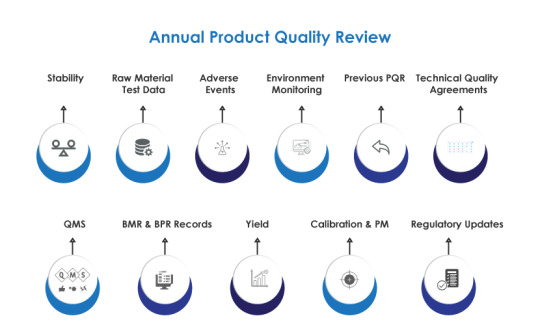
AmpleLogic APQR Software: Elevating Quality Assurance in Pharmaceuticals
In the tightly regulated world of pharmaceuticals, ensuring the quality of every product is not just a commitment but a legal mandate. The Annual Product Quality Review (APQR), often known as the Product Annual Review, serves as the linchpin in upholding current good manufacturing practices (CGMP) regulations, as outlined by the FDA.
AmpleLogic's APQR Software emerges as a powerful solution, streamlining the APQR process and transforming it into a dynamic tool for quality management.
Key Features for Seamless Quality Assurance
AmpleLogic's APQR Software boasts features that significantly enhance the efficiency of the Product Quality Review (PQR) process. It automates the generation of APQR documents based on predefined templates, ensuring consistency and accuracy. Teams can generate PQR reports at any time, and the system includes auto-alerts for delays, ensuring timely reviews.
The software manages master data, offering statistical analysis and trends on critical parameters such as Assay, Water Content, PH, Specific Impurities, and Total Impurities. It goes beyond standard reporting by providing batch-wise trends, enabling tracking of granulation yield, compression yield, coating, and packing yield.
Comprehensive Data Capture for Informed Decision-Making
AmpleLogic's Product Quality Review Software is not just a compliance tool; it is a repository of comprehensive information. It captures batch details, process yields, raw material information, deviations, stability trends, and more. Categorized month-wise and condition-wise, the software offers a holistic overview of a product's journey from production to market.
Beyond the pharmaceutical sector, the software extends its benefits to diverse industries, including Biologics, Medical Devices, Chemical Industry, Contract Manufacturing Organizations, Generics, and Food & Beverages.
Insights through Process Capability Analysis
One of the standout features of AmpleLogic's APR Software is its ability to perform Process Capability Analysis. Leveraging data from Laboratory Information Management Systems (LIMS), Electronic Quality Management Systems (EQMS), and Batch Manufacturing Records, the software employs statistical methods defined in the R Language to calculate key indices—Cp, Cpk, Pp, and Ppk. These indices provide insights into process variations, ensuring manufacturing processes remain robust.
Immediate alerts for Process Deviations add another layer of responsiveness, allowing teams to address issues promptly. The software's continuous process verification capability ensures ongoing scrutiny of manufacturing processes, aligning with Six Sigma standards for consistent quality.
Global Compliance and Adaptability
The APQR Software by AmpleLogic doesn't operate in isolation. It aligns with major regulatory standards, including 21 CFR PART 11, MHRA, and EU Annex 11. This global compliance ensures that the software can seamlessly integrate into the operations of pharmaceutical companies worldwide.
Goodness-of-Fitness Test: Strengthening Analytical Capabilities
Incorporating a Goodness-of-Fitness Test, the software introduces a robust statistical method to validate observed values against model predictions. This test, crucial in decision-making, ensures that the data used for analysis adheres to predefined norms.
The software's adaptive approach, including various transformations and consideration of different distributions, underscores its commitment to data integrity.
Conclusion: Transforming Quality Assurance
In conclusion, AmpleLogic's APQR Software transcends traditional quality assurance practices. It is not merely a tool for compliance but a catalyst for continuous improvement and excellence.
With its global compliance, adaptability across industries, and powerful analytical features, the software positions itself as a transformative force in the pursuit of manufacturing excellence.
In a world where precision and quality are non-negotiable, AmpleLogic's APQR Software emerges as a beacon, ensuring that every product reaching the market adheres to the highest standards.
To gain a more in-depth understanding of our APQR Software, request a demonstration at: Click here to Request Demo
0 notes
Photo







AmpleLogic Team Outing _Leonia Holistic Destination
0 notes
Text
AmpleLogic, Second New Office Opened at Gachibowli





#AmpleLogic commenced business in 2010 with five people with a single software solution. Today, with more than 100 employees & having sales presence locations around the world, AmpleLogic is a being a recognized player in “Rapid Application Development” space i. e; “Low Code Platform”. We have grown tremendously over the past few years. AmpleLogic has customers in all major regions of the globe & in nearly all industry verticals
We have doubled our sales & marketing, development teams & opened a #secondnewoffice in late January at #Gachibowli, #Hyderabad, additionally to our existing facilities in Madhapur,Hitech City, Hyderabad
The expansion is in conjunction with strong demand for AmpleLogic diverse range of customized applications, impressive growth, broadening of its product offerings & continues to offer customized solutions based on the expectations of clients & the products will be delivered with high quality at cost-effective & at specified timelines
Continuing on the same path, we are ready to invest more to increase its product offerings & acquire fresh talent professionals to provide world-class cutting edge solutions to more companies
0 notes
Text
Quality Management Software
We live in a world that’s changing rapidly and it’s logical that the organization, as well as customer requirements, can evolve all the time. Your Quality Management System (QMS) must keep up with these changes and should be improved continuously to stay/remain consistent with the changing circumstances of the business. Only by doing this will the QMS’ performance improve and you may be able to identify and exploit new opportunities.
To find out more, visit https://bit.ly/2Suc7JI
Free demo schedule, amplelogic.com/contact-us
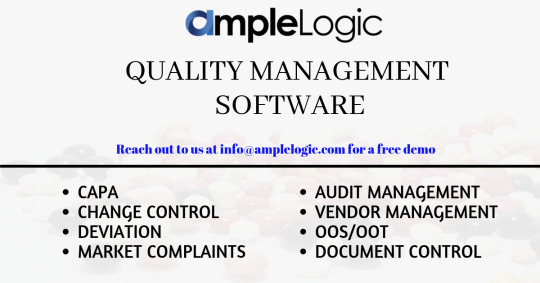
0 notes
Text
AmpleLogic - CPhI Worldwide in Frankfurt, Germany
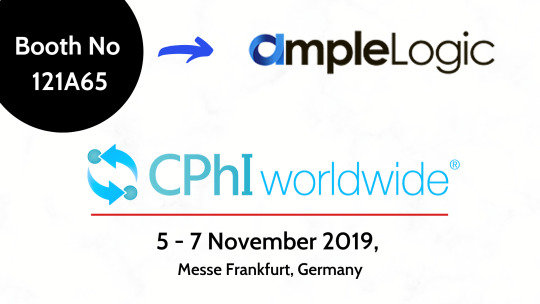
Meet us at CPhI Worldwide in Frankfurt, Germany from 05 - 07 November 2019! Join us at booth #121A65 to meet our representatives and to know more details of AmpleLogic extensive experience and optimal Portfolio of solutions to meet our customers’ needs
If you are attending and would like to meet, please email us at [email protected] to schedule a meeting
For more details about AmpleLogic, visit www.amplelogic.com
#pharmaceutical industry#drug manufacturing#lifesciences#biotechnology#medicaldevices#healthcare#CPhIWorldwide#cphi2019#cphi#amplelogic#QualityAssurance#qualityControl#quality#GMP#cGMP#qualitymanagementsystem#documentmanagementsoftware dms documentcontrol dmssoftware amplelogicdms
0 notes
Photo
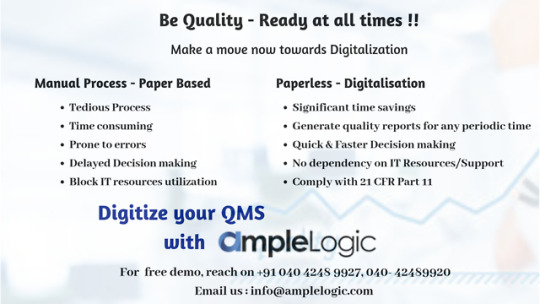
Are you frustrated using paper and spreadsheets to manage your quality system?
Are you spending hours of hours for creating quality reports that you're not sure anybody actually reads?
#AmpleLogicQMS is available for immediate implementation as a Pre-Configured Web Solution for Quality Assurance, with support for Process Automation, Document Control and many more. #AmpleLogic Pharma Web QMS can also be extended with modules to provide elegant solutions to most Quality and Compliance related challenges – while allowing you to scale the system to your needs
For more information, visit https://bit.ly/2UIhQZe
1 note
·
View note
Photo
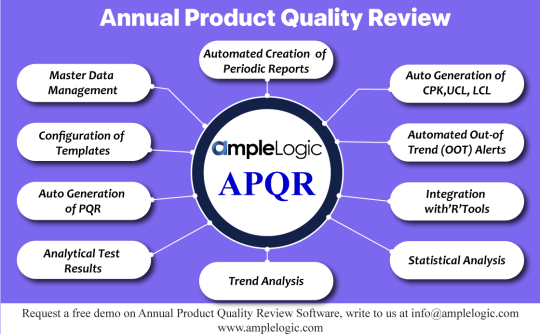
Annual Product Quality Review (PQR Software)
Nowadays, several #pharmaceutical drug manufacturing industries are spending to invest a huge sum of money, manpower, and a lot of time and energy in their of #Annual Product Review
Learn how to save a significant amount of time and effort by #AmpleLogic APQR Software: https://bit.ly/3muaiHw
To see #AmpleLogic ‘PQR’ Solution in action, please schedule a #demo or get in touch with us via email at [email protected]
0 notes
Photo
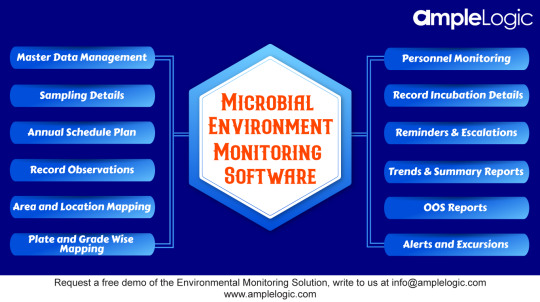
AmpleLogic Microbial Environmental Monitoring Software developed for managing #microbiological data of the environmental monitoring programs, especially for #lifesciences and #pharmaceutical companies.
This software tracks all the monitoring process, from #sampling to microbiological identification, passing through phases of #incubation process and reading results
Schedule a free #demo with our product experts to see AmpleLogic Solution in action, write to us at [email protected]
If you want to learn more about the software, visit https://bit.ly/3jjbL2E
0 notes
Photo

AmpleLogic Team would like to wish Merry Christmas and A Happy New Year to all of you. We hope this festive season brings joy, blessings, health, and peace to all of us.
0 notes